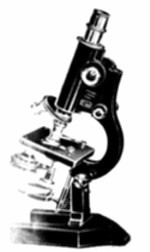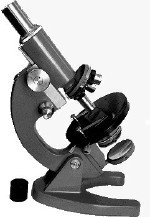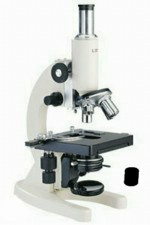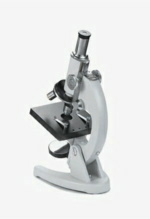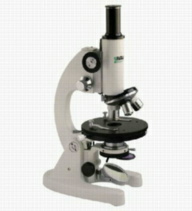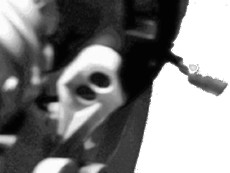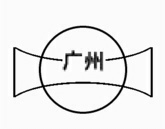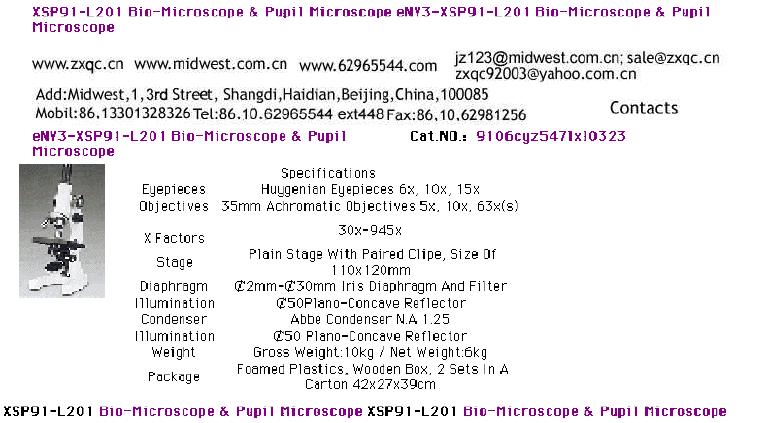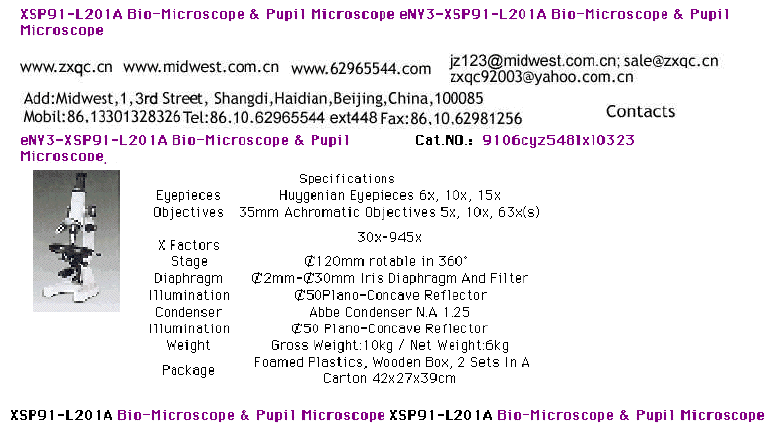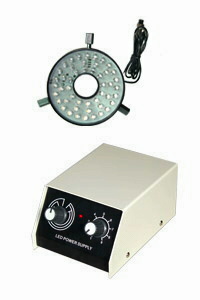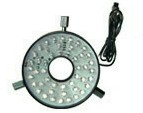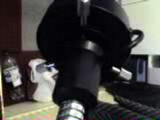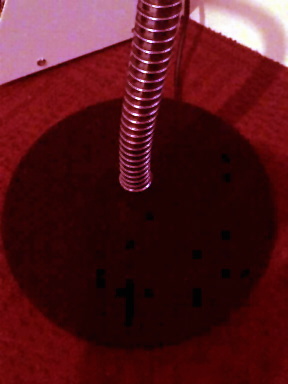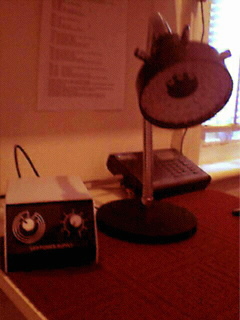|
| Ask anyone to describe what they envisage a microscope to look like today, and the picture that they would present would be something probably approaching that of the images shown on the left. They look similar, but there are subtle differences in the designs. The Universal Compound Monocular Light Microscope is probably one of the most familiar designs of microscope, in the world, and of this family, the Model L-201 is exact to that traditional standard and pedigree. It has its roots in a British Design Patent, (Becks Standard Model 1, source: Allen and Hanburys. Pre World War I), was adopted, adapted and then modified for the United States Market by American Optical USA, where the microscope became more fully bodied to suite the American market. The microscope sold in the AO catalogues around 1934 as the American Optical design Standard Lab Model. One of the distinquishing features of this influence, was a movement towards a longer mechanical tube length of 201 mm, just under eight inches. The microscope also gained some more mass, weighing in at 4 metric kilograms, just under 9 lbs. In the 1920's the stand looked more like a Nikon, with Art Nouveau styling much like the original Olympus Showa design. But whereas Nikon designs tend to be formed of curves uppermost to the stem, the Beck, and American Optical models were at first more linear and blocked upon the stem. During the 1930's this styling took on the Art Deco influence under American Optical production in the US, and this influenced the styling of Zeiss microscope production in Europe. In Europe, the microscope was standardised and existing models of microscope with longer mechanical length tube were refitted to conform to the 160mm 6 inch standard, by replacement of the ocular tube, from 85mm (inclusive of the 5 mm concealed thread) to 45mm, granting a total mechanical tube length of 160mm, not 201 mm, as originally specified by the US revision of the Beck. In its original longer form, the microscope could be applied to metalographic, and histological biomedical applications. That humble Beck Standard Model 1, had grown bigger in size, and earned wings, but not quite so in Europe, that still maintained the 160mm or 170mm tube lengths. After the Second World War, production, was reinitiated in Japan, and some of the antiquated designs of the American Optical pre Second World War period were transferred to Japan and adopted and improved by Olympus Optical Instrument Co. research specialists, under the Post War redevelopment alliance of Japan and the US. One of the significant aspects of the Olympus design was the restyling of the horseshoe base to give the microscope more stability in situ. The former Y shaped base of the Spencer tradition, became a U shaped base, and the blocked ends of the microscope acquired the rounded bevels at the front. Through the partnerships of this design evolution and under the management of the Olympus Optical Company, with its established brand name, and its multiplicity of pseudonyms, such as OIC, Minolta, etc., and an ever extending international support facilities, that were based on the older versions of American Optical design patterns, the G series microscope saw its greatest success in the International market. The many fold manifestations of the G series stands, include the GA, GB ,GC, GK, the Olympus POS, the HSC, HSA, HSB, and ST models that were produced for the educational market. Further, OSK models embrace the same design compatibilities such that stands under this brand find purposeful function in and about atomic research and environmental analysis, and aviation industries. Its advantages are several, ease of maintenance, ease of use, extremely high power capacities, price, and uniformity of structure, compliancy of parts, compliancy to mass manufacturing processes, which make this microscope, affordable, and principal above all others for life long use. There may be some that dispute this, but I shall leave the critics hunting for that annoying little screw part, that is unique to a microscope, 10 years down the line, when the fads and styles of the day have moved on. In the British Isles, the Post War era was not good for the microscopist. The main major microscope manufacturing crafts had been annihilated during the bombing of many of the cities that had manufacturing facilities in their centralised industrial bases and those that never suffered greatly from damage during in the war, failed later against competition from overseas mass manufacturing processes which prevented their return. Many of the famous brands of English made microscope survived only in name, there were still many retail shops, and craft bases in the family business, but through successive mergers, names such as Beck, Baker, and the microscopes of, Cooke, Troughton and Simms, came to be unified, gradually, under one main industrial base, ostensibly Vickers. That Beck Standard Model 1 evolved to be, the Vickers, Model 26, via the Beck Baker Cooke Troughton Simms mergers, till finally all models took on the G series form, from American Optical influence. By the 1970's, the G series microscope had come to be manufactured in China, Guangzhou, as interests within the Japan mainland switched to newer designs, and Olympus introduced a newer range of microscope designs, for its other plants. Manufacturing in Guangzhou, which is also known as Panyu, Gongdong and in Japanese Canton, was at first, under licence from Olympus and then later, the microscope was independently marketed from the factory under Chinese National Instrument Import Export Company branding, when Olympus ceased to include the microscope in its portfolio, around the time of the introduction of the Vanox range in 1972. In the UK, by this time, much if any of the traditional microscope production had ceased, there were mergers and take overs, as a product of the fad of European integration. For example, Philips microscopes bought out what was left of the traditional family businesses, of yesteryear, and new designs were only the products of Vickers, alone. During the 1970's Phillips shut its microscopy manufacture, during the 1990's Vickers ceased its production and innovation of designs, like American Optical, many of the UK microscopy manufacturers ceased to exist, period. All that remains is the crafts and skills of enthusiasts and restorers. In contrast, in China, and Japan, the story is very different. The Guangzhou company still had to produce microscopes, even though Olympus had chosen not to furnish Europe with G series designs. But the G series design within Olympus was still required, and the continuum of production in Guangzhou provided two functions: First, the POS microscope appears not to have been deleted from the Olympus catalogue, even up until 1996. Second, with so many microscopes in the market place, support connections still required there to be manufacturing resources, for parts. Indeed still today, Guangzhou can provide a multiplicity of parts and accessories for their models. When Olympus OIC, Optical Industrial Company, revised and updated their microscope range at the start of the 1970's, the G microscope range was dropped from the portfolio of the Olympus showroom to the West, but it never vanished entirely. Western educational establishments, with a commitment to the microscopes already in their possession were left confounded both by the decision by Olympus Optical Instrument Company to drop the microscope from its portfolio and also confounded in terms of their requirement for support: after all, up until that time, Olympus had provided support direct. Even more surprising, it is to find that original, OIC G Series and Olympus stands are still available today, to buy new in some areas of the extensive manifold branches of the Olympus company, notably Olympus Optical of India. Guangzhou still have great success, with the L-301 a quadruple version of the L-201. The production licenses for the production of the microscope stand rests with the Guangzhou Liss Optical Instrument Factory, Guangzhou China, and the International trading rights of International distribution, rest with the Chinese National Instrument Import Export Company of China. The official China National Instruments L-201 microscopes bear the London underground type globe and banding trademark that is shown below. The official Olympus microscopes of the same form bear their respective traditional Olympus trade mark. The Guangzhou Liss Optical Instrument Factory, which is now the Guangzhou Liss Optical Instrument Company, therefore, plays an essential role in supporting all merchants throughout the world, with optical products of exceptional quality. Forthwith I refer to this manufacturing source in China, as GLOIC. The L-201 and more recently the L-301 are Industrial Grade, and conform to the original specifications in parts and performance introduced under the influence of Olympus in China. The Guangzhou Factory is unrestricted in production and is currently finding tremendous success with a wide portfolio on wonderful new products, maintaining all attention to detail of their craft, pedigree of exceptional design and conformity to the norms and conventions of the existing market. Consequently, Olympus G series HSC series, parts and accessories are completely compliant to microscopes produced by the Guangzhou factory, and distributed by China National Instrument Company. Microscopes from Guangzhou are available in the west from GX optical who maintain the presence of the Occident in the West. If I were to be critical of the failing of this microscope it would be in the arena of information and specifications of manufacture, part numbers, and conformity of standards, not much appears on the factory web site detailing the construction patterns and standards and documentational support, not in the construction of its design pattern. More has to be done in that arena of China, for provisions of Western technical support requirements. The China National Instrument Company Microscopes from Guangzhou differ in two ways to the original microscopes offered by Olympus. The round stage platform of the L-201 does not have the provision of holes to accommodate a slide measure super stage as standard. The lower side of the filter unit has a swing filter, and is not the interchangeable filter unit on the original Olympus Abbe. Both of these inconsistencies can be overcome by fitting the appropriate stages or accessories for the task in hand if and when required. Phase contrast sets, for example, are available either from Paralux, or as accessories from Yujie or GLOIC. Olympus platforms can be fitted to accommodate superstage accessories. |
